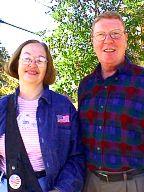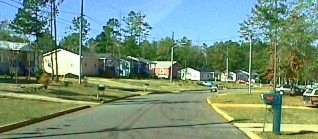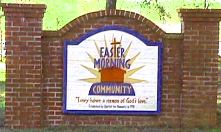Habitat for
Humanity
Buildings
and Museum
Americus GA.
December 1st, 2001
From time to time, while
traveling through America, we would come across a church or other
building which displayed a large sign proclaiming the activities of Habitat for
Humanity. I was always curious about the signs and what they
represented. So when we passed through Georgia, we made a stop in
Americus at the International headquarters and took a tour of the
facilities. Here we met a most delightful gentleman who became
our guide for the afternoon. David Bottomley who originally
hailed from Bradford England, retired from the textile industry
and has been working with Habitat for Humanity since 1999. A most
energetic and enthusiastic guide, he took us through the original
Habitat neighborhood, then on to the Easter Morning Community,
the largest community construction ever undertaken by Habitat and
finally to the newly designed Global Village which is still under
construction. Our tour started at the headquarters building from
1978 to 1987 at 419 Church St. This amazing story had its
beginning
proclaiming the activities of Habitat for
Humanity. I was always curious about the signs and what they
represented. So when we passed through Georgia, we made a stop in
Americus at the International headquarters and took a tour of the
facilities. Here we met a most delightful gentleman who became
our guide for the afternoon. David Bottomley who originally
hailed from Bradford England, retired from the textile industry
and has been working with Habitat for Humanity since 1999. A most
energetic and enthusiastic guide, he took us through the original
Habitat neighborhood, then on to the Easter Morning Community,
the largest community construction ever undertaken by Habitat and
finally to the newly designed Global Village which is still under
construction. Our tour started at the headquarters building from
1978 to 1987 at 419 Church St. This amazing story had its
beginning in the small southwest Georgia town of
Americus. Fired by a vision of a world with no more shacks, in
which every family would have the opportunity to live in a
simple, decent house. Millard Fuller and his wife, Linda, founded
Habitat for Humanity International. Using their experiences
building houses in partnership with poor families of Koinonia, a
nearby Christian community, and as Disciples of Christ
missionaries in the former Zaire, the Fullers began working out
of a small office in Americus. 25 years since its beginning,
Habitat for Humanity has built more then 100,000 houses around
the world. The ultimate mission is the eradication of inadequate
shelter, wherever it exists in the world. The organization is
broken down into Affiliates. An affiliate is an independent
nonprofit organization responsible for directing habitat house
building work in its community. Although Habitat International
offers advise and assistance, all affiliates are responsible for
the legal, organizational, fund raising, and financial
requirements, as well as doing the work needed. We were invited
to watch an introductory video which explained the beginnings and
the basics of what makes this most
in the small southwest Georgia town of
Americus. Fired by a vision of a world with no more shacks, in
which every family would have the opportunity to live in a
simple, decent house. Millard Fuller and his wife, Linda, founded
Habitat for Humanity International. Using their experiences
building houses in partnership with poor families of Koinonia, a
nearby Christian community, and as Disciples of Christ
missionaries in the former Zaire, the Fullers began working out
of a small office in Americus. 25 years since its beginning,
Habitat for Humanity has built more then 100,000 houses around
the world. The ultimate mission is the eradication of inadequate
shelter, wherever it exists in the world. The organization is
broken down into Affiliates. An affiliate is an independent
nonprofit organization responsible for directing habitat house
building work in its community. Although Habitat International
offers advise and assistance, all affiliates are responsible for
the legal, organizational, fund raising, and financial
requirements, as well as doing the work needed. We were invited
to watch an introductory video which explained the beginnings and
the basics of what makes this most unusual organization work. At the International
center, volunteers make up a solid core of the work force. Some
33 houses have been bought and rehabbed for living quarters for
the 100 to 150 volunteers. In addition a stipend is offered to
cover such expenses as food and other domestic coasts. As we
drove slowly down the neat clean streets looking at the well kept
houses, Dave explained that many of them had been built in the
1980s and were still occupied by the original owners or their
descendants. I marveled at the cleanliness of the community. So
often I had been witness to America's give away programs falling
apart in filth and disrepair soon after their construction. The
quality of this community fascinated me. "Habitat for
Humanity is no giveaway program", Dave assured me, Each
prospective owner must qualify for acceptance into the program.
The homes are not for the integrant. A working income is a
requirement, for there is a mortgage to be paid back to
unusual organization work. At the International
center, volunteers make up a solid core of the work force. Some
33 houses have been bought and rehabbed for living quarters for
the 100 to 150 volunteers. In addition a stipend is offered to
cover such expenses as food and other domestic coasts. As we
drove slowly down the neat clean streets looking at the well kept
houses, Dave explained that many of them had been built in the
1980s and were still occupied by the original owners or their
descendants. I marveled at the cleanliness of the community. So
often I had been witness to America's give away programs falling
apart in filth and disrepair soon after their construction. The
quality of this community fascinated me. "Habitat for
Humanity is no giveaway program", Dave assured me, Each
prospective owner must qualify for acceptance into the program.
The homes are not for the integrant. A working income is a
requirement, for there is a mortgage to be paid back to  Habitat,
and there are definite restrictions on selling the property while
still under mortgage, such as it can only be sold back to
Habitat. Still, those who do qualify, could have never qualified
under the financial burden of a conventional home loan. What they
lack in financial ability is made up in what Dave called
"sweat equity". Each recipient must work on the
building project themselves, at what ever level they are capable.
Hundreds of hours of work are normally spent as a replacement for
financial ability. This is often spread out over a longer period
time involving work on several other houses. From here we drove
to the edge of town to visit the Easter Morning Community.
Situated on 63 acres, this development will ultimately house some
142 houses.
Habitat,
and there are definite restrictions on selling the property while
still under mortgage, such as it can only be sold back to
Habitat. Still, those who do qualify, could have never qualified
under the financial burden of a conventional home loan. What they
lack in financial ability is made up in what Dave called
"sweat equity". Each recipient must work on the
building project themselves, at what ever level they are capable.
Hundreds of hours of work are normally spent as a replacement for
financial ability. This is often spread out over a longer period
time involving work on several other houses. From here we drove
to the edge of town to visit the Easter Morning Community.
Situated on 63 acres, this development will ultimately house some
142 houses. Each house designed as a single family dwelling
on a full 1/3 acre of land. Desiring to avoid the "cookey
cutter" appearance, Habitat produced many different floor
plans and color schemes. Recipients are able to pick their own.
Many of the houses have concrete roof tiles after a generous
donation by the manufacturer. Basements were avoided, with the
houses being leveled by brick supports. This often left a crawl
space under the structure. Street lights and paved roads were
donated by the city of Americus. The subdivision gets it name
from the building experience. In 1998, starting on Palm Sunday
and ending on Easter Sunday, 20 homes were
Each house designed as a single family dwelling
on a full 1/3 acre of land. Desiring to avoid the "cookey
cutter" appearance, Habitat produced many different floor
plans and color schemes. Recipients are able to pick their own.
Many of the houses have concrete roof tiles after a generous
donation by the manufacturer. Basements were avoided, with the
houses being leveled by brick supports. This often left a crawl
space under the structure. Street lights and paved roads were
donated by the city of Americus. The subdivision gets it name
from the building experience. In 1998, starting on Palm Sunday
and ending on Easter Sunday, 20 homes were constructed in a blitz building challenge. Team
work and planning were the key factors. In 1999, again the Holy
Week saw hundreds of construction workers descend on the
community to build 25 homes over the same period. Like wise in
the year 2000, 30 home were constructed. From here we moved on to
the high point of the visit. The Global Village. Here are
reproductions of the structures that have been built in the many
countries that Habitat has been operating in. Although only in
its infancy, the village already is a fascinating place which
clearly shows the challenges and accomplishments which have been
met. Set against a mural covering one wall. The interlocking mud
bricks used to build homes in Sri Lanka and Fiji were
constructed in a blitz building challenge. Team
work and planning were the key factors. In 1999, again the Holy
Week saw hundreds of construction workers descend on the
community to build 25 homes over the same period. Like wise in
the year 2000, 30 home were constructed. From here we moved on to
the high point of the visit. The Global Village. Here are
reproductions of the structures that have been built in the many
countries that Habitat has been operating in. Although only in
its infancy, the village already is a fascinating place which
clearly shows the challenges and accomplishments which have been
met. Set against a mural covering one wall. The interlocking mud
bricks used to build homes in Sri Lanka and Fiji were  displayed.
These blocks are resistant to earthquakes. Each block has a slot
through it and holes with raised rims. The blocks interlock and
grout is poured into the rectangular slots. Reinforcement bars
can be inserted into the round holes for support. The bricks are
made on site with the use of a small hand press. Two people
working for one week can make enough bricks for a normal house.
The bricks must sit in the shade for about two weeks before they
are ready to use. Families often earn their sweat-equity required
of each family by making these bricks. The conditions change from
country to country depending on what is available. Ingenuity is
part of the process, figuring out what will work best under which
circumstances. This was both an informative and interesting
afternoon. It is amazing what can be done when people of good
heart and faith put their heads and hands together for the good
of mankind.
displayed.
These blocks are resistant to earthquakes. Each block has a slot
through it and holes with raised rims. The blocks interlock and
grout is poured into the rectangular slots. Reinforcement bars
can be inserted into the round holes for support. The bricks are
made on site with the use of a small hand press. Two people
working for one week can make enough bricks for a normal house.
The bricks must sit in the shade for about two weeks before they
are ready to use. Families often earn their sweat-equity required
of each family by making these bricks. The conditions change from
country to country depending on what is available. Ingenuity is
part of the process, figuring out what will work best under which
circumstances. This was both an informative and interesting
afternoon. It is amazing what can be done when people of good
heart and faith put their heads and hands together for the good
of mankind.
*** THE END ***
